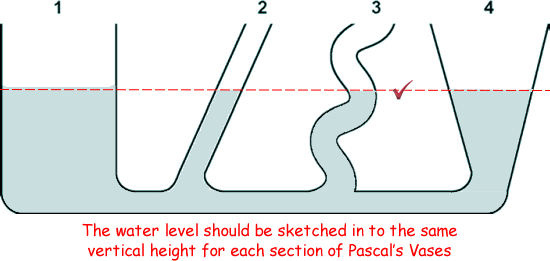GCSE Questions: Pressure, buoyancy, upthrust and fluids Q3. The diagram shows an unusually shaped container. The container has four vertical tubes of different shape and size.
(a) Water is poured into the container up to the level shown in tube 1. Complete the diagram to show the height of the water in tubes 2, 3 and 4. [1 mark] (b) The further a swimmer dives below the surface of the sea, the greater the pressure on the swimmer. Explain why. As he dives deeper, he increases the height/mass/volume of the water column above himself. [2 marks] (c) A person swims from a depth of 0.50 m to a depth of 1.70 m below the surface of the sea. Given that: the density of the sea water = 1030 kg/m3 and that the gravitational field strength = 9.8 N/kg, calculate the increase in pressure on the swimmer as he dives deeper. Δ pressure = Δ depth x density of liquid x gravitational field strength Δp = Δhρg increase in depth = 1.70 - 0.50 = 1.20 m Δp = 1.20 × 1030 × 9.8 Δp = 12,112.8 Δp = 12,000 Pa (or 12 kPa)
[4 marks] [7 Marks TOTAL] |
Follow me...
|






